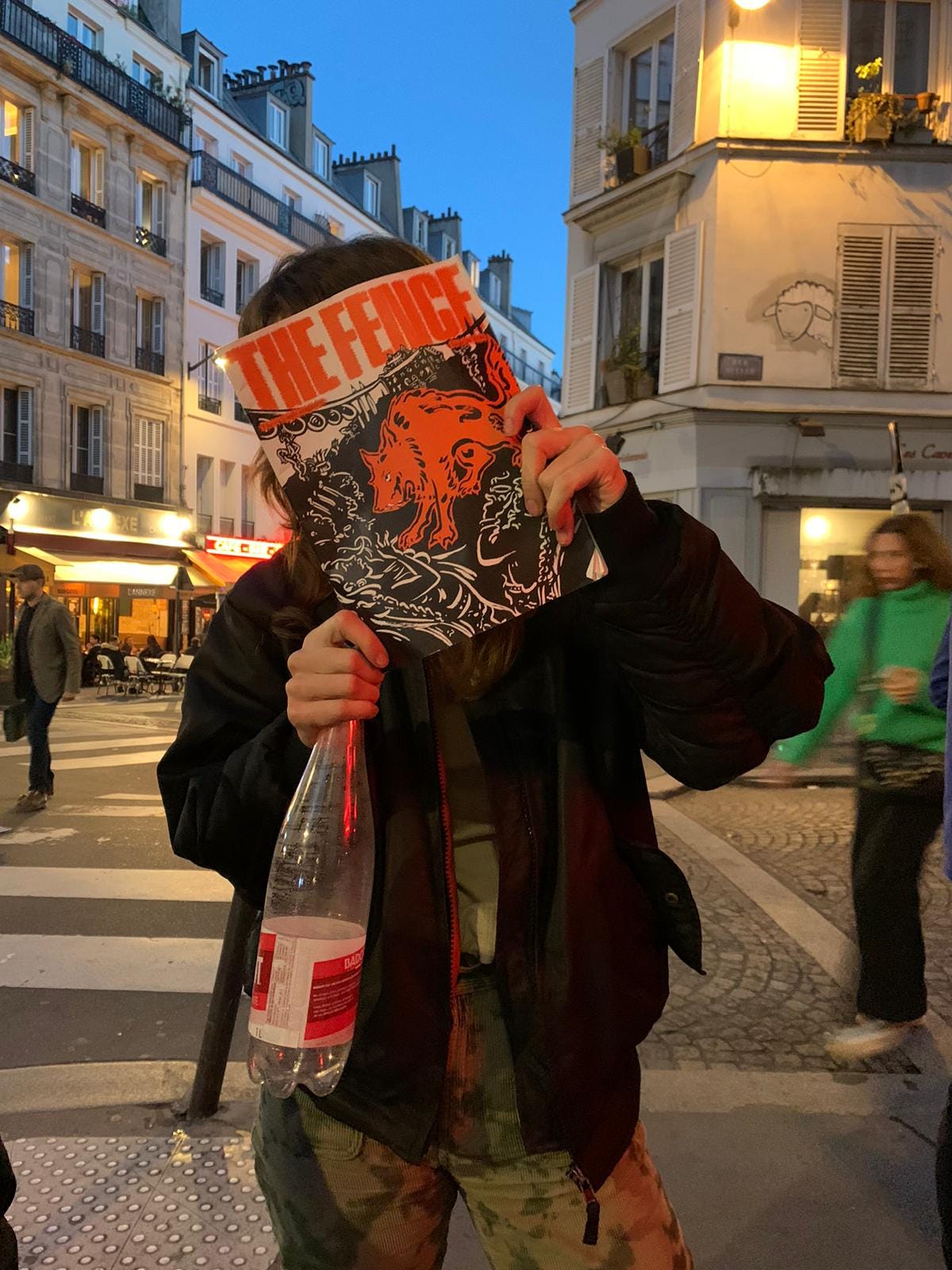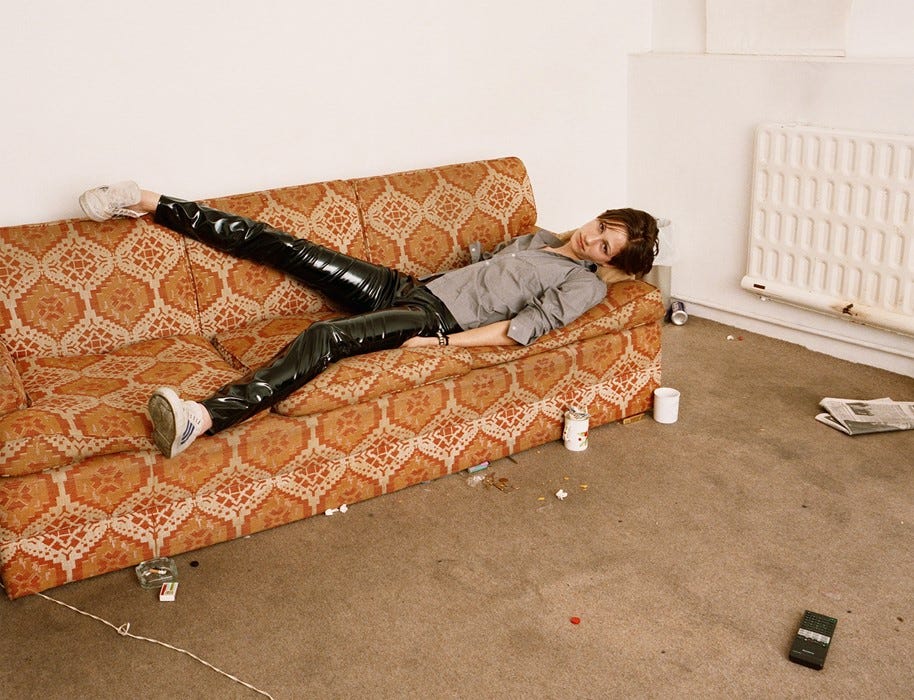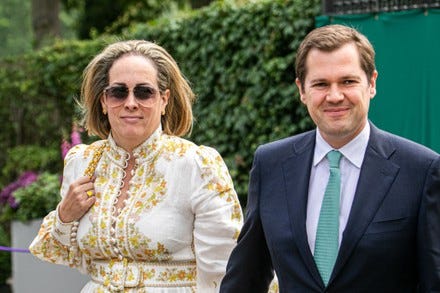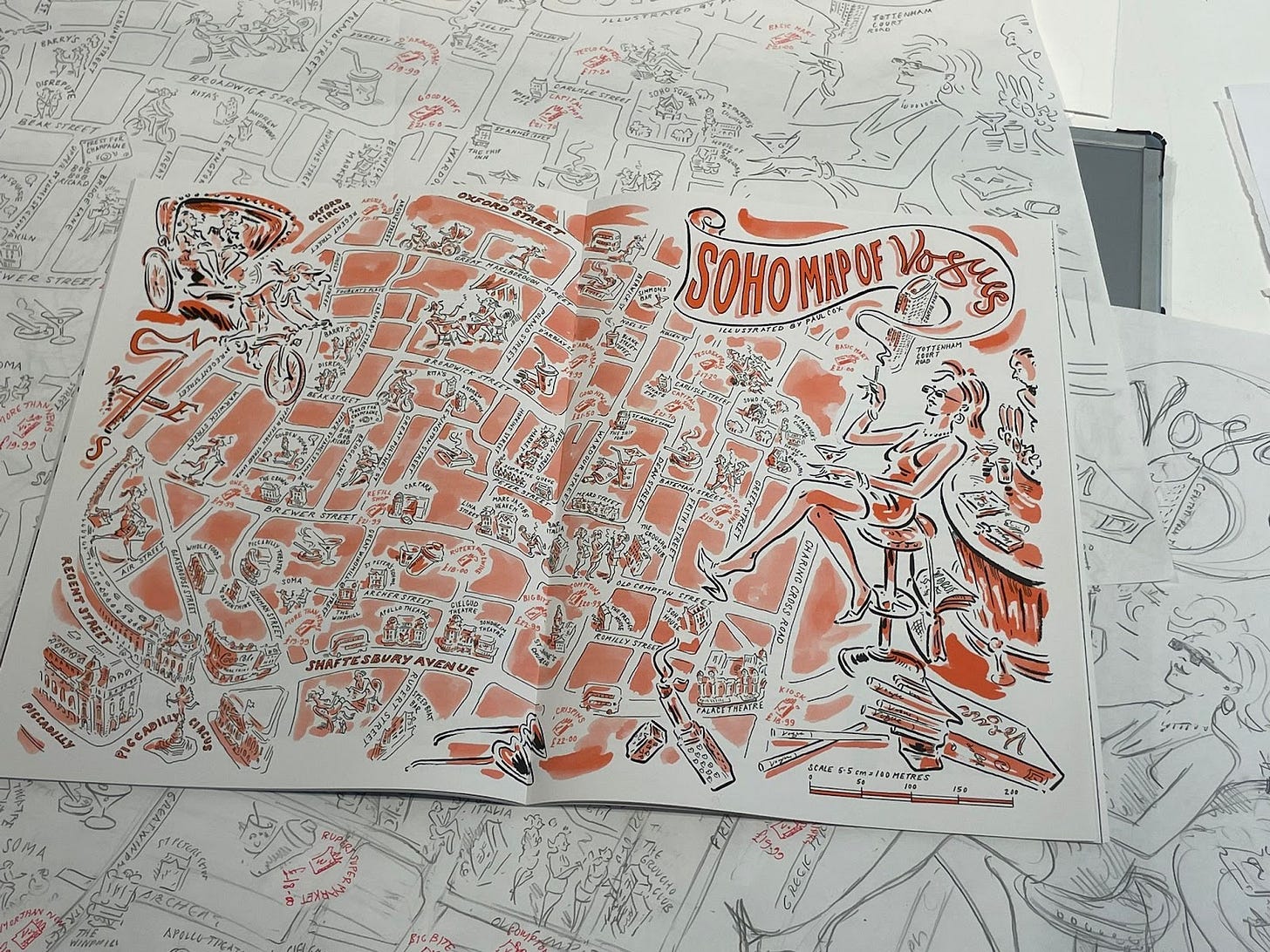Dear Readers,
Good afternoon, and welcome to Off The Fence, a newsletter coming to you from a suddenly sunny Soho. Issue 21 is with subscribers and is proving a palpable smash. Please do keep sending these photos in, it lends a twinkle to the working day.
So far, the issue has been spotted in the fields of County Kildare; in gay Paree; alongside another must-read chronicle; at breakfast in St James; somewhere within Scotland; with some homemade chutney and lauded composer Daniel Pemberton has gone so far as to say that it’s his favourite magazine. Well, there you have it.
Long-time readers know the drill: if you share a particularly winning snap of the magazine, you can win a bottle of Bollinger Champagne, which is generous of us. Keep them coming on social media or to editorial@the-fence.com if you’re feeling nervous.
Today, we’ve got some bits on our beloved neighbourhood in its summer season, courtesy of Bernard Ginns (great name, by the way). Let us B. Ginns.
Frith and Carlisle
If you loved jazz, you had come to the right place. If you couldn’t stand it, you had arrived at the former home of the Royal Dispensary for Diseases of the Ear, a 19th-century institution founded for the relief of ailments ‘to the last degree painful and inconvenient’. Either way, you could find comfort and convenience in the pizza and Peroni at Pizza Express Jazz Club, at the corner of Dean Street and Carlisle Street in Soho, central London. Whether you were a fan of the genre or not, the venue had established itself as one of the best in Europe, playing host to legends of jazz since founding in 1976.
When I turned up at the towered building in early 1997, down from university in Manchester with a practically useless degree in philosophy and seeking a career in the capital, Pizza Express was in its pomp and Dean Street the flagship of a listed restaurant group with a stock market valuation of £380m. It felt like Britain was in the ascendancy with New Labour on the verge of power. I was hired on the spot and so began another level of education: learning how to wait tables, deal with the public and speak to strangers. Being where it was, located at the intersection of Britain’s creative industries in the era of Cool Britannia, many of the diners weren’t actually strangers at all.
After one lunchtime shift, a familiar face appeared at the door. I smiled reflexively on recognition. The comedian Harry Enfield smiled back and asked for a table for one. The restaurant was empty, the lull between late lunch and early dinner. I said he could sit wherever he liked. He chose the table next to the till, ordered some pizza and a drink, consumed them both and asked for an ashtray. Actually, he was sitting in the non-smoking section, I told him. His face did a kind of flounce, like his Kevin the Teenager character. I couldn’t help but laugh. On this occasion, we made an exception and I brought him an ashtray.
Enfield’s TV co-star from The Fast Show, Mark Williams, visited another day. When the future Father Brown asked for the bill, I told him it was on the house; it was at the manager’s insistence, I explained, for giving the nation a good laugh. Which was nice. Tony Slattery, a talented comedian of the same generation, also dined alone, some sadness in his kind open face as he ordered his second bottle of red wine. In 2020, he featured in a BBC documentary about his bipolar disorder, addiction and childhood trauma.
Late one night, just before closing, Graham Coxon and his partner arrived for pizza. Ordinarily, staff would groan at late arrivals after a long shift. One of my colleagues was a huge fan and quite overwhelmed at his guitar hero’s appearance. Normally an outgoing character, he nervously approached the couple at the end of their meal and asked for an autograph. Coxon took the pen and produced a vivid illustration on a serviette, sweetly signing his name.
One weekend, the Texas singer Sharleen Spiteri hosted a large group in the back of the restaurant. I took her the bill at the end of their meal. She looked at me thoughtfully as she signed the slip. It was by far the biggest tip I would receive in two years at Dean Street. You can say what you want about her soulful rock, but she was a generous customer. Perhaps she had not forgotten her service sector roots as a hairdresser. Another night, Graham Norton and a companion joined us. He had worked in the restaurant trade as a young man and knew the score.
We lived off our tips and we kept our own: there was none of this nonsense about giving the company a cut. We were an international crew from France, Spain, Italy, Portugal, South Africa, Serbia, Croatia, Sweden and Brazil. We rubbed shoulders with visiting jazz musicians, US performers like Scott Hamilton, Chick Corea and Mose Allison (he of ‘Ever since the world ended, I don’t go out as much’). We Brits were a minority and tended to be aspiring singers, actors or media types, like me. One went on to become an award-winning film producer, making his name in gangster movies.
But that was then and more than a quarter of a century later, Soho has changed. Many of the creative industry companies that populated the district have gone elsewhere, driven away by the flattening shift from analogue to digital. Much of the work of film, TV and music production now takes place in the cloud, rather than the old hunting grounds of Soho.
Many of the celebrities have also gone elsewhere. Back in 1997, it seemed they were all at Dean Street: the casts of the decade’s standout TV dramas Our Friends in the North and This Life, the superstar DJ Goldie and then girlfriend, the even starrier singer Bjork, the TV titans Michael Grade and David Frost, the artist Damien Hirst and even the Manchester impresario Tony Wilson. I remember the founder Peter Boizot standing in the middle of his restaurant, walls lined with jazz festival posters by pop artist Eduardo Paolozzi, packed with faces from the film, TV and music industries, and surveying his pizza palace.
Pizza Express, now privately held, has changed too (although I see Scott Hamilton is still playing at the jazz club). At the end of last year, net debts totalled £431m. A new, new Labour has taken power. Does it still feel like Britain is in the ascendancy?
You can follow Bernard on Twitter here.
Banville This Sick Filth
Our newly released magazine includes, amongst our coterie of fine young authors, the Booker Prize-winning upstart John Banville. For Issue 21 Banville recounted a memorable meal he had in a delightful Umbrian taverna, and we have stuck his treasured memories online for you to peruse at your leisure – right now, we are living vicariously through John’s gauzy October afternoons instead. If you’d like to join us, read along here.
Bamford This Sick Filth
Lord Bamford is the country’s leading industrialist: he has expanded his family’s JCB empire into India, China and the USA. His wife, Carole, helms Daylesford Organic, which started as a farmshop near their Gloucestershire home and has since mushroomed into an all-enveloping lifestyle empire that is subsuming this corner of the Cotswolds. But what do the locals think? And is it in the best possible taste? Claudia Cockerell reports from Clarkson Country.
Too Full of The Milk of Human Kindness
The part of political spouse is an odd and spiky role to play. You are criticised for the clothes you wear and who bought them for you (Mrs Starmer), for being on the dole (Mr Harris-Emhoff) and even for being a spy for Confederate forces (Mrs Lincoln). Truly, who would want this; a statesmanlike platform that's more of a millstone around a neck than a career achievement? Nobody more, it seems, than Mrs Robert Jenrick.
Michal Berkner, the allegedly-51-year-old wife of the Tory leadership candidate, is an odd fish. Where most political spouses spend most of their time in public life in a ceaseless quest to embody normality and relatability, Berkner seems to revel in her oddness. A ‘force of nature’ lawyer, she sports a gold necklace that reads ‘wifey’ and an unchanging, Hyacinth Bouquet style blowout. She believes in the power of Ozempic and in her work as a defender of law and order assisted a consortium of four oligarchs years before they were all sanctioned after Russia’s invasion of Ukraine. Deeply, noticeably American, she met Jenrick, nine alleged years her junior, in 2006, and now lives in a ‘a girls’ house, plus Rob’, in Herefordshire.
Today, the Tory party will decide on whether Michal gets one step closer to becoming Lady Victoria’s understudy. We of course wish her all the best.
Vogue Tonight Queen?? 👀
Will Keir Starmer be brave enough to address in the government's forthcoming budget the true scourge of pricing in this country? We doubt it. And so we have preemptively taken up the mantle to support the girlies and otherwise girlie-coded citizens of Soho in his absence. We are talking, of course, about the price of Vogue cigarettes in central London, a scalping situation which grows more and more dire by the day.
Several months ago our contributing editor, Róisín Lanigan, spent an afternoon intrepidly cataloguing the price of Vogues in every shop in a reasonable radius, after suffering PTSD when she was charged £25 for a pack just off Oxford Circus. The resulting map, illustrated in our newly released Issue 21 by Paul Cox, means none of you will ever suffer in the same way again.
Nonetheless, we have again arrived at new heights of public service journalism by creating a treasurable, collectible print of the Soho Map of Vogues, for your future referencing. We have ordered 50 copies, and there are now only 25 available, signed by the artist, in A2 size right here: Get 'em while you can, smoke 'em while you got 'em. Only £40.
Physick Dancehall
The world’s eyes were fixed on Stockholm earlier today, as the annual Nobel Prize for ‘most amount of physics done in one year’ was handed out to – and we hope this isn’t demeaning to say – two very hard-working young scientists. Geoffrey E. Hinton, 78, and John J. Hopkins, 91, were jointly handed this year’s gong ‘for foundational discoveries and inventions that enable machine learning with artificial neural networks’.
Blessedly, we’re now mates with loads of Nobelists, after two rounds of asking them the stupidest questions we could think of, and we can say with confidence that these garlanded boffins are more like the rest of us than you might expect. If you want to hear whether Prof. Frances Arnold (Chemistry, 2018) emails notes to herself, or how Jon Fosse (Literature, 2023) justifies his pen collection to his wife, read part one here, and part two in Issue 21.
In Case You Missed It
One from the archives: Willy Staley on what the newly returning McRib says about the vicissitudes of the US economy, for The Awl (RIP).
Francisco Garcia tells the fascinating 25-year saga of George Blake, beginning with his prison break.
Nobody has time to be a good mate anymore! So says Laura Pitcher
The New Republic charts a year of Joe Biden’s catastrophic path through the conflict in the Middle East
And Gillian Anderson talks to the New Yorker about sex. (We’ll be able to see if this gets the most clicks, by the way.)
And Finally
We’re not in the business of breaking news that often in this newsletter, but this one feels like a scoop that nobody has touched yet: Sue Gray, the Prime Minister’s Chief of Staff, has resigned from her position after weeks of negative media attention. As this is the first you’ll be hearing of this, we’ll give you a moment to process the news.
Moment of silence observed, we now move on to the fun bit – have you seen her husband? As it transpires, Mr Sue Gray (known elsewhere, but not here, as Bill Conlon) was once the superstar catch of the now-former gatekeeper to Starmer, as one of Portaferry’s foremost country & western stars.
Playing with his band Emerald, or occasionally solo with only four chords and a heart full of pain to guide him, Mr Sue Gray enjoyed modest prominence in the embattled North, one of the few enclaves outside of Tallahassee to adore country music like the cowboys do.
The unlikely pair managed the Cove Bar in the border town of Newry together in the 1980s, and one can only imagine the rapturous cheers that Mr Sue Gray enjoyed from their audience of ruddy-cheeked townsmen, small-time arms traders and British informants.
You came this far for a weird video, and do we not dutifully deliver? For your viewing pleasure – shit, for your next house party – here’s a 57-minute set of Mr Sue Gray and Emerald playing hits from Conway Twitty and, if YouTube’s artist-scraping infobox is to be believed, the Thai rapper Lisa, formerly of Korean girl group BLɅϽKPIИK.
*
That’s it for this week, if you have any other questions, please do get in touch at support@the-fence.com and we will attend to you promptly. Until the next time.
All the best,
TF








